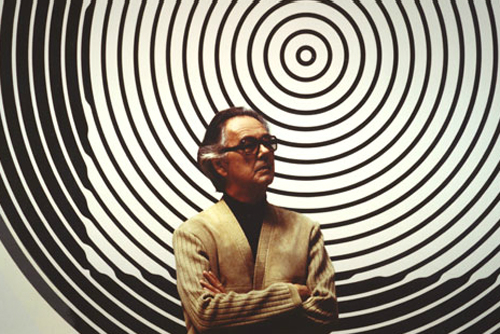The "Grandfather" of Op Art: Who is Victor Vasarely?
Many artists had an influence on the birth of Op Art, but the early works of Hungarian-French artist Victor Vasarely considered the "grandfather" of Op Art, on geometric patterns and optical illusions in the 1930s, formed the basis of Op Art.

Vasarely was inspired by the theories of Bauhaus, Suprematism, and geometric abstractions and shaped his works in these directions. His paintings aimed to take people out of their visual comfort zones, leading minds to doubt and new ideas through the pleasant tension created by seemingly moving images. He was experimenting with optical art, playing with colors and shapes.
Victor Vasarely established an unusual relationship between color and form with a system he called "Alphabet Plastique". This “alphabet”, a grid-based system, introduced a modular approach to Vasarely's works and offered a new language to the art world.
Who is Victor Vasarely?
Victor Vasarely, whose real name was Győző Vásárhelyi, was a Hungarian visual artist born on April 9, 1906, in Pécs, Austria-Hungary. He later acquired French citizenship in 1961. The artist, who is considered the father of optical art, passed away on March 15, 1997, in the 16th district of Paris, France...
Vasarely initially studied medicine but dropped out after two years. He later became fascinated with the Bauhaus movement and worked in Sándor Bortnyik's studio in Budapest from 1929 to 1930.
In 1930 he moved to Arcueil with his wife Claire Spinner (1908-1990), first temporarily residing in the Plas studio and later at 1, avenue Jeanne-d'Arc. Vasarely started his career as a graphic artist, working for advertising agencies such as Havaş, and Draeger. Around this time, he created his groundbreaking work, Zebra (1937), which is now considered the first work of the op art genre.
In 1934, Vasarely and Claire welcomed their son Jean-Pierre (d. 2002), also known as Yvaral, who became a visual artist and collaborated with his father.
Victor Vasarely (9 April 1906 – 15 March 1997) was a Hungarian-French artist, who is widely accepted as a "grandfather" and leader of the Op art movement. His work titled Zebra, created in 1937, is considered by some to be one of the earliest examples of Op art.
During the war, Vasarely met Denise René in Paris and eventually opened his own gallery, dedicating his first exhibition to her in 1944.
In 1948 the couple fell in love with Gordes (Vaucluse) and in 1970 they founded the Vasarely Museum. The museum was supported by a foundation established by Vasarely and his wife in 1971, but faced management difficulties and was closed in 1996.
Over the following two decades, Vasarely developed his unique style of geometric abstract art, experimenting with a variety of materials while applying a minimalist approach to shapes and colors.
Vasarely's limited number of religious works include depictions of Jesus and St. Peter. These works of art belonged to the town of Charenton-le-Pont and were displayed in the crypt of Evry Cathedral until December 2018. In addition to these pieces, Vasarely designed twenty-five stained glass windows for the ecumenical church of Saint-François d'état. Assise, Port-Grimaud, Var.
Vasarely also collaborates with various companies. In 1972 he and his son worked together to transform the Renault logo. This partnership led to the creation of a series of artworks installed along French motorways. Vasarely believed that highways represented a harmonious blend of natural and artificial landscapes. It drew on the technical expertise of Renault's paint laboratories, which recommended the use of enameled sheet metal to ensure resistance to the elements.
In the same year, Vasarely designed the metal strip-clad façade of RTL's Paris studios, located at 22, rue Bayard in the 8th arrondissement. This particular work, currently listed as Monument Historique, was removed when the radio station moved on 23 October 2017. It was later donated to the Vasarely Foundation, based in Aix-en-Provence.
In the 1970s, Vasarely also created the facade of the Claude-Nicolas-Ledoux secondary school in Dole, cementing his status as one of the leading artists of the 1960s and 1970s. On March 15, 1997, at the age of 90, the artist passed away in Paris, France, leaving behind a rich artistic legacy. Vasarely's work has been widely exhibited around the world and he has also been involved in numerous architectural projects, integrating his artistic vision into public buildings and urban spaces.
The significance of Vasarely's legacy, which paved the way for countless contemporary artists, is profound. While his enduring influence on optical and kinetic art is undeniable, his vision of creating accessible and universal art continues to inspire and resonate with creators around the world.
